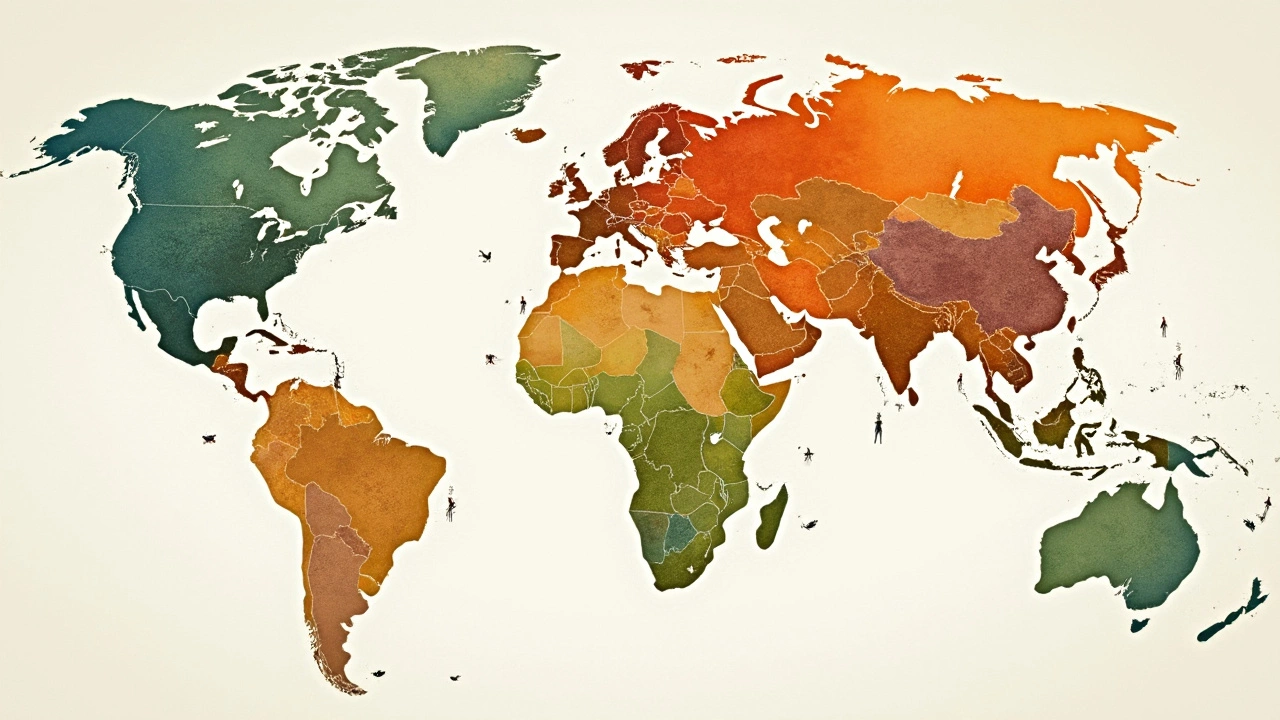
Ever wondered why some folks have to skip the bread basket while others dive right in? Celiac disease is a condition where gluten—a protein found in wheat, barley, and rye—doesn't play nice with the digestive system. It causes a pretty serious reaction, but not everyone worldwide is affected equally.
Scandinavian countries like Finland and Sweden, along with regions in Northern Europe like Ireland, top the charts for celiac disease prevalence. It's not just about genetics, but other factors like the environment and diet might play their part. Think about how these populations historically rely on certain grains—it's fascinating how that history ties into health issues today.
For those living with celiac, or if you're wondering if you're at risk, going gluten-free isn't just a trend—it's essential. But fret not, there's more to it than just restriction. From mouthwatering gluten-free cakes to alternative grains, there's a world of tasty, safe options out there!
- Celiac Disease Overview
- Nationalities With Highest Prevalence
- Factors Influencing Celiac Disease Rates
- Impact on Gluten-Free Diets
- Tips for Living Gluten-Free
- Future of Celiac Research
Celiac Disease Overview
So, what exactly is this celiac disease everyone's talking about? Basically, it's an autoimmune disorder where eating gluten damages the small intestine. Gluten, the protein that gives bread that chewy texture, triggers a response in folks with celiac, leading to serious health issues if untreated.
When people with celiac consume gluten, their immune system starts doing a number on the small intestine's lining. The villi, which are tiny hair-like structures responsible for nutrient absorption, get damaged. Over time, this can lead to nutritional deficiencies, growth problems in kids, and a whole host of digestive issues.
The tricky bit is, not everyone who feels off after eating gluten has celiac. Some might have gluten sensitivity, which isn't quite the same deal. With celiac, there's actual damage happening inside.
Recognizing the symptoms is key. They range from bloating, diarrhea, and stomach pain to more subtle signs like fatigue and skin rashes. In some cases, people might not show any gut-related symptoms at all!
- Family History: If you've got a close family member with celiac, your chances of having it go up significantly.
- Associated Conditions: Folks with autoimmune disorders like type 1 diabetes or autoimmune thyroid disease are at a higher risk.
- Testing: The standard way to diagnose is through blood tests and a biopsy of the small intestine.
According to the University of Chicago Celiac Disease Center, about 1% of the world's population is affected. That might not sound like a lot, but it's estimated that around 80% of cases remain undiagnosed. Spotting the signs early and getting tested can be a game-changer.
Sounds overwhelming? Sure, but with the right information and support, managing celiac disease becomes a whole lot easier. Knowledge is power, after all!
Nationalities With Highest Prevalence
Some countries have way more people with celiac disease than others. Ever wondered why there’s a gluten-free aisle in almost every Finnish grocery store? Finland, along with Sweden and Ireland, often sees higher rates of celiac than many other places, with about 1 in 100 people dealing with it. It could be thanks to a mix of genetic factors and traditional eating habits.
A 2023 study noted that in Scandinavian countries, there's a particularly strong connection between genetics and gluten intolerance. Diet over the centuries in these regions has leaned heavily on rye and wheat, which might have played a role. Surprisingly, Italy also has a significant number of celiac cases. Italians love their pasta, but many need to choose gluten-free options out of necessity rather than preference.
"Understanding celiac prevalence among nationalities is crucial, as it guides both cultural dietary adaptations and medical recommendations," says Dr. Jane Thompson from the World Celiac Organization.
On the opposite side, some regions like Asia and sub-Saharan Africa have historically lower cases. Their staple foods, such as rice and maize, naturally lack gluten. But, as Western diets become more global, these stats might shift.
| Country | Prevalence Rate (%) |
|---|---|
| Finland | 1% |
| Sweden | 1% |
| Ireland | 1% |
If you’re noticing more gluten-free options popping up around these regions, it’s no coincidence. There’s an increasing awareness of dietary needs, driven partly by these high prevalence rates.
Factors Influencing Celiac Disease Rates
Diving into why certain nationalities face more cases of celiac disease than others reveals some intriguing patterns. It’s not just your DNA playing a role. Let’s break down what influences these numbers.
Genetics is a biggie. If you’re of Northern European descent, like Irish or Scandinavian, you might carry genes like HLA-DQ2 or HLA-DQ8 connected to gluten intolerance. But having the gene doesn’t mean you’ll definitely get celiac disease. It’s just a bigger slice of the risk pie.
Here comes where you live into play. In countries like Finland and Sweden, where gluten-rich diets are common, more people end up being diagnosed. They’ve relied heavily on grains like rye and wheat historically. Such dietary habits can trigger the disease in those already carrying the genes.
Isn't it cool how even hygiene can influence celiac rates? The “hygiene hypothesis” suggests that super-sanitized environments could mess with our immune systems, making it more likely to overreact to gluten. This might explain why rates in developed countries are higher.
While environmental factors spice things up, so does awareness! Countries with active screening programs spot more cases earlier. Not a bad thing really, catching it early helps manage it better with a gluten-free diet.
Here’s a quick glance at why some places see more cases than others:
| Factor | Impact |
|---|---|
| Genetics | Higher in Northern Europe due to specific genes |
| Dietary Patterns | Reliance on gluten-rich foods historically |
| Hygiene Hypothesis | Higher prevalence in sanitized environments |
Wrapping it all up, you see how a mix of hereditary, environmental, and lifestyle factors make some folks more prone to celiac disease. Knowing this can really help tailor better dietary choices and health strategies!

Impact on Gluten-Free Diets
Celiac disease isn't just a health condition—it's a lifestyle shake-up. When those with celiac must ditch gluten, it significantly shapes their daily food choices. And let's be real, you can't escape gluten in most traditional diets, especially in regions with high celiac rates.
Finland, with a noted celiac prevalence, sees a strong emphasis on gluten-free alternatives. Grocery stores there often have aisles dedicated to gluten-free products. This shift isn't just about having options; it's about catering to a real need. Restaurants are catching on, too. More menus are flaunting 'GF' labels, making dining out less of a hassle.
But what does going gluten-free really mean for your diet? It's not just swapping pasta for rice—you're talking about a nutritional reboot. Ensuring you get all the nutrients without the wheat can be tricky, but not impossible.
Here are some handy tips for making your gluten-free diet work:
- Load up on naturally gluten-free grains like quinoa and buckwheat.
- Don’t just focus on what you can't eat—discover new recipes with fresh fruits, veggies, and nuts.
- If buying processed gluten-free foods, watch for added sugars and fats. Healthy doesn't always mean healthy!
And here's a fun nugget of info: Some studies suggest that a higher intake of dietary fiber from gluten-free grains may actually be better for your gut. Not every gluten-free eater experiences this, but it’s worth noting!
| Country | Celiac Prevalence (%) |
|---|---|
| Finland | 1.5 |
| Ireland | 1.4 |
| Sweden | 1.3 |
The numbers show these regions where celiac is common, driving a strong demand for gluten-free products. This global shift towards gluten-free options is a game-changer for those with celiac disease and even those without. It's a food revolution that bridges cultures and dietary needs around the world.
Tips for Living Gluten-Free
Being diagnosed with celiac disease can feel like a bummer at first, but fear not! Living gluten-free is totally doable, and might even open your eyes to new culinary adventures. Here are some practical tips to help you on your journey.
Firstly, get familiar with food labels. Gluten loves to sneak into unexpected places, so become a detective. Look out for those grains like wheat, barley, and rye in ingredient lists.
If you’re dining out, don’t hesitate to ask questions. Restaurants often have gluten-free options or can adapt dishes for you. A quick chat with the chef or server can make all the difference.
- Stock up on staples: Ensure your pantry is filled with gluten-free grains such as rice, quinoa, and cornmeal. They're the real MVPs in gluten-free cooking.
- Find your favorite substitutes: There’s no shortage of gluten-free bread, pasta, and flour mixes these days. Take time experimenting with different brands to find what suits your taste.
- Join a community: Whether it’s online or in-person, connecting with others in the celiac community can provide support and new ideas for gluten-free living.
Did you know that according to a 2024 survey, 90% of people with celiac disease reported significant improvement in their symptoms once maintaining a gluten-free diet? That’s some solid encouragement.
Lastly, don't forget to treat yourself. Dive into making or buying delicious gluten-free cakes and desserts. After all, everyone deserves a sweet reward now and then!
Future of Celiac Research
The world of science never hits the pause button, especially when it comes to understanding conditions like celiac disease. With more attention on this issue, researchers are pulling out all the stops to explore new ways to better manage and maybe even prevent this gluten intolerance globally.
One exciting area of research is in genetics. Scientists are keenly looking at specific genes that seem to be more common in those with celiac disease. By identifying these genetic markers, they hope to screen for and diagnose the disease much sooner. Imagine being able to tell if you need to go gluten-free before you even start eating solid food!
There’s also some groundbreaking work in developing enzyme supplements that could help break down gluten, making it less harmful for those with mild intolerance. While not a substitute for a gluten-free diet, these enzymes might offer a little wiggle room for those accidental slip-ups.
For those interested in the techy side of things, wearable technology might just be the next big thing. Gadgets that monitor gluten intake are being developed, allowing users to catch cross-contamination early.
Finally, there’s hope in the world of vaccines. Researchers are working on a way to train the immune system not to overreact to gluten. Imagine a world where eating pizza doesn’t lead to a day of discomfort!
It’s thrilling to think about how these advancements could change the lives of those living with celiac disease. While full of potential, these developments are still in the research phase, but they hold promise for a future where having a slice of cake isn’t off-limits!





